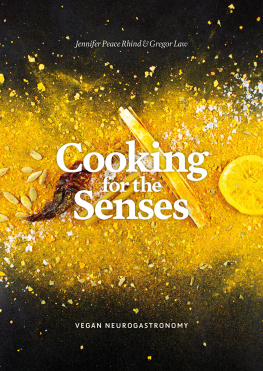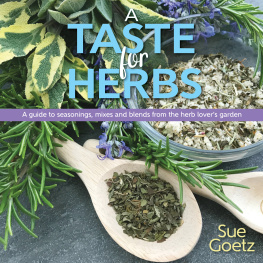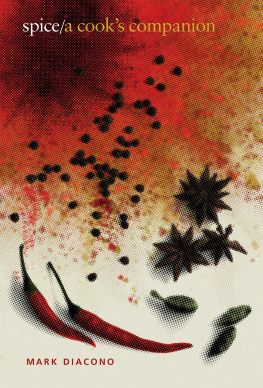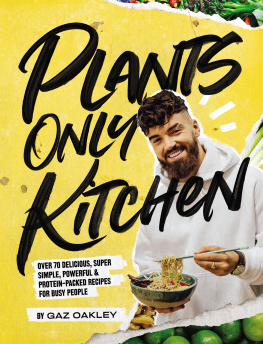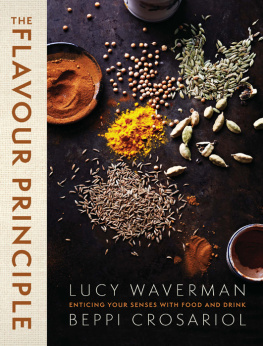

Contents
Preface
N eurogastronomy introduces an alternative and inspiring way of looking at food and flavour, and changes the way we might perceive plant-based cuisine perhaps breaking a few prejudices along the way. We look at the science behind the senses, which helps us understand our individual likes and dislikes, and introduce some kitchen science, which helps us understand how to maximise flavour. A wide range of ingredients from the plant kingdom are explored from the flavour perspective, and we present recipes that reflect neurogastronomy in action. But we hope that this is not a dry read; in the spirit of neurogastronomy, we have seasoned it with tales of our own culinary experiences, from the sublime to the ridiculous such is the human palate!
You may well ask why this is a book about plant ingredients and cuisineand so here is some insight.
According to my mother, I began to reject meat and poultry when I was a toddler. I think that this was because I did not enjoy the texture of flesh in my mouth. As a child, I dreaded the visits to the local butchers shop, where the sights and smells nauseated me. My first determined foray into the world of vegetarianism was when I was a teenager in the late 1960s to early 1970s, and my father (rather unfairly) blamed Pink Floyd and my musical heroes for this worrying development probably because they represented the counterculture of the era. My mother gamely prepared lentil roasts, and eventually my father became a pescatarian! However, like most of us who are interested in good food, I experimented with my palate, and a world of exciting flavours was revealed at least within my self-imposed limits (poultry was never ever on the menu!). For decades, I lived as a flexible vegetarian and an occasional fish and seafood eater. So, why did I become vegan? The rise of the internet and freely accessible information about how our food is produced was making it difficult for me to reconcile my eating habits with my conscience. A vegan friend, Joe Bergin, posted an image on Facebook. It was a close up of a pigs eye, with the mirrored reflection of the horror of his surroundingsand then one of a cow with tears streaming down her face. They are all exactly the same as us, in that they are sentient beings; they have families, social bonds, feelings, emotions. And that, for me, was it. I literally became a vegan in that instant. I stopped making excuses for the sake of my palate, and I began to follow a vegan lifestyle. When I told family and friends about my choice, there were mixed reactions, the most common being Oh my goodness, what on earth can you eat? However, any time I was asked to explain myself, the most common responses were each to their own or you do yours, I do mine (i.e. please dont lecture me on my lifestyle choices!), or I dont have issues, but (followed by gentle jibes and/or justifications), or I hope you will not be vegan when you come over for dinner (yes, really), or I admire you but I couldnt Then, of course, there were those who assumed it was for the good of my health, and somehow that made it acceptable, or, conversely, that I would be missing out on vital nutrients and, of course, protein, and then there were those who went down the line of defending the farming industries.
All of this taught me a great deal as Robert Burns wrote, O would some power the giftie gie us to see ourselves as others see us. The various perspectives that were expressed (often defensive in tone) enabled me to explore my chosen lifestyle from the viewpoint of others, and this ultimately changed the way that I communicate my feelings and ideals. Like many individuals, I dont like being labelled or categorised, and prefer instead to let my personal beliefs and convictions be reflected in how I live, not simply by what I eat.
So, I am not here to take the moral high ground. This book is all about flavour. When I became vegan at first, despite being a competent cook, I experienced what I can only describe as a sort of paralysis in the kitchen. Suddenly, some of my staple ingredients were no more. It was my research background and experience in the flavour industry, and then as an aromatherapist, essential oil educator, writer, and student of artisan perfumery, that came to my rescue. I began looking at vegan cuisine from the aroma perspective of herbs and spices, and from there it was a natural progression to explore the flavours of all the amazing plant ingredients at our disposal. I realised that neurogastronomy was the key to elevating plant-based cuisine to where it belongs up there with the very best of vegetarian and omnivorous cuisines! Greg is integral and instrumental in this his recipes embrace the spirit of neurogastronomy and are inspirational in every sense of the word. Go on explore, immerse yourself, create, share, enjoy!
To those who might think that a plant-based diet is difficult to follow and missing your favourite animal-derived ingredients, I would say this: focus upon all the plant ingredients that you enjoy , rather than what you choose not to eat, and you might come to realise that this way of eating is about abundance rather than restriction, and about kindness and compassion and that in itself is a very good feeling indeed.
Preparing food for others is an act of love. A form of giving, and directing our attention away from the self, it goes beyond simple feeding and extends into the realm of nurturing minds, bodies and souls. Eating together is important too; we can form rewarding and enduring friendships over plates of food. And when our palette of ingredients comes exclusively from the plant kingdom, we are also being kind to the planet and our fellow sentient beings that live here with us.
The Recipe Collection will inspire you, and encourage you to stretch and develop your palate and culinary repertoire, while the Exploring Flavour section can be your own voyage of reflection and discovery.
This book is for everyone who would like to deepen their understanding of cooking with plant ingredients and flavour creation a vital part of our global culinary future and so it is also a handbook for a new era of eating well, in every sense of the word.
For the animals which share our world, and show us how we can become better humans,
Jennifer

Understanding
Taste and Flavour
We are the only species on the planet which prepares meals.
L et us take a moment to reflect upon this statement. Why is eating such an important sensory experience for humans?
If we watch our omnivorous canine companions eating dinner, we see perhaps a quick sniffing session followed by a head in the bowl, swallowing or even bolting food, courtesy of their adapted tongues and their open/shut jaw motion there is no chewing or savouring of every bite! Leeloo, our first exuberant gold-and-white Tibetan Terrier, ate quite voraciously, whereas our chic and gentle, black-and-white Gertie is much more circumspect and dainty. Then, if we look at our carnivorous feline friends catching and eating their prey (or, in Harry the black panther cats case, illicitly sampling the Iberian ham), we see their little needle-like, sharp teeth and claws tearing at the flesh; again, anything that is consumed is accomplished with little evidence of chewing because feline jaws are not adapted to chew. Now consider the cow the big, gentle herbivore and observe its jaw motion as it chews the cud at a leisurely pace while taking in its surroundings. I am sure that you will agree that no other species, whatever the facial adaptations, appears to take the same sort of pleasure that we humans take in eating indeed, some make a profession out of eating well and are known as gourmands!
Next page
